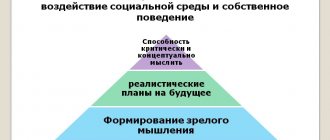Every child tends to be capricious from time to time. Sometimes this happens for obvious reasons: tired, nervous, offended someone, faced injustice. But there are entire periods when uncontrollable and intolerable behavior is not limited to one situation, but continues for several months. Disobedience, hysterics, protests, rude speech, refusal to make contact - the list of problems can be endless.
In this difficult period, it is difficult to find any logical explanation for what is happening. Those who are familiar with psychology know that age-related crises are to blame for everything.
What it is
Childhood crises are transitional stages from one stable (lytic) life period to another, characterized by a holistic change in the child’s personality, caused by the emergence of psychological new formations. To designate them, Vygotsky introduced the term “normative crises of development.”
There are many different approaches to their definition and classification (Vygotsky, Elkonin, Erikson, Leontiev, Bozhovich, etc.). Despite such diversity, they are all very similar and agree on most key points.
Psychology explains them quite simply. All children grow in leaps and bounds, during which, according to research, the brain begins to actively emit impulse waves. Scientists have yet to find out their nature and significance, but at these moments significant changes occur with mental and physical development.
Physical changes
Just yesterday he was crawling, but today he is already clumsily walking. Just yesterday I couldn’t do without outside help, but today I’m tying my shoelaces and trying to make breakfast for myself. Just yesterday my daughter was an angular, clumsy teenager, and today she has turned into a beautiful, mature girl.
Mental changes
Each age-related crisis period is accompanied by neoplasms. At 1 year - this is autonomous speech, motivating ideas, self-image. At 3 years old - primary independence, building more complex relationships, a new level of self-awareness, volitional regulation of activity. At 7 years old - arbitrariness and indirectness of actions, awareness of one’s own experiences, new social roles. At 13 - an exaggerated sense of adulthood. At 17 - professional and personal self-determination.
Why are these surges called crises? Because they represent a difficult transitional state to a new level - both physically and mentally. This process is not easy not only for parents, but most of all for the child himself. He is afraid of the dramatic changes that are happening to his body and worldview. And in response to them he begins to protest, trying to run away and hide from such a development of events. Hence the uncontrollable behavior.
Age-related crises of preschool childhood
MAOU "Center for Psychological and Social Support "Family""
ABSTRACT
Topic: Age-related crises of preschool childhood: symptoms, individual characteristics of manifestations.
Course: “Psychological and pedagogical foundations of special pedagogical assistance to children with speech disorders.”
Completed by: Geiko O.V. educator
MBDOU "Kindergarten No. 185"
Checked by: Chertenkova G.I.e.p.n. assistant professor
Department of O&D&P of the Center for Professional Education NFI KemSU
Novokuznetsk, 2018
- The concept of crisis, crises of preschool childhood.
Crisis (Ancient Greek κρίσις - decision, turning point) - a revolution, a time of transition, a turning point, a state in which the existing means of achieving goals become inadequate, resulting in unpredictable situations. [1] Age-related crises arise as a result of transition from one age stage to another and are associated with systemic transformations in the sphere of social relations, activity and consciousness. Thus, researchers such as L. S. Vygotsky, A. N. Leontiev, D. B. Elkonin, Z. Freud, E. Erikson, L. Bozovic, S.L. Rubinstein, A.V. Zaporozhets and others.
Elkonin D.B. in his works he comes to the conclusion that a crisis is a period of rapid changes in the child’s psyche, characterized by increasing difficulties in communication between an adult and a child, which are a symptom of the fact that the child already needs a new relationship with him. Such periods alternate with stable ones, during which changes are barely noticeable. [11,10]
At the same time, the course of crises is extremely individual and variable (this depends, in particular, on the behavior of adults).[11,10]
Most researchers believe that during preschool childhood (from three to seven years) it is customary to distinguish two critical periods - the three-year crisis and the seven-year crisis. Let's look at each of them in more detail.
- Three-year crisis: symptoms and individual characteristics of manifestations.
For different children, the crisis of three years can begin at different times, but, in general, this period passes between the ages of 2-2.5 and 5-5.5 years. In girls it usually begins earlier than in boys and usually goes away more easily. At 2-2.5 years old, the baby begins to distinguish himself as an individual from the world around him, his dependence weakens, and the child begins to realize his autonomy and self-worth. It is from this time that he quite consciously says “I,” differentiating himself from other people. [8]
By the age of three, the child begins to develop his own desires that do not directly coincide with the desires of adults. At an early age, there were no particular discrepancies between the desires of the child and the adults. If a child wanted something prohibited, adults quickly switched his attention to another attractive object. By the age of three, the child’s desires become definite and stable, which is confirmed by the persistent words “I want.” The sharply increased desire for independence and independence from adults towards the end of early childhood, both in the actions and desires of the child, leads to significant complications in the relationship between the child and the adult. This age is critical because over the course of just a few months the child’s behavior and his relationships with other people change significantly.[10]
L. S. Vygotsky described the following symptoms of the crisis of three years. The first of them is negativism
. This is not just disobedience or unwillingness to follow the instructions of an adult, but the desire to do everything the other way around, contrary to the requests or demands of elders. With negativity, a child does not do something just because he was asked to do it. Moreover, such a desire often harms the child’s own interests.
For example, a child who really likes to walk refuses to go for a walk just because his mother suggests it. As soon as his mother stops persuading him, he insists: “Go for a walk! Walk!" With a strong form of negativism, the child denies everything that the adult tells him. He may insist that cheese is butter, blue is green, and a lion is a dog, etc. But as soon as an adult agrees with him, his “opinion” changes dramatically to the opposite. A child who acts and speaks contrary to an adult acts and speaks contrary to his own feelings. Here the child’s behavior not only does not depend on perceived circumstances, but also contradicts the evidence. This behavior is caused not by the objective situation, but by the attitude towards the person, towards the adult. The child acts contrary to his desires and evidence in order to express his attitude towards another.
The second symptom of the three-year crisis is stubbornness
, which should be distinguished from persistence. For example, if a child wants an item and persistently strives for it, this is not stubbornness. But when a child insists on his own way, not because he really wants it, but because he demanded it, these are already manifestations of stubbornness. The motive behind stubbornness is that the child is bound by his original decision and does not want to deviate from it under any circumstances. Here again one can observe the exact opposite picture of the situational behavior and desires of a 1-2 year old child.
The third symptom of this age is obstinacy.
This symptom is central to the crisis of three years, which is why this age is sometimes called the age of obstinacy. Obstinacy differs from negativism in that it is impersonal. The child’s protest is not directed against a specific adult, but against a way of life. The child begins to deny everything that he calmly did before. He doesn’t like anything, he doesn’t want to go hand in hand with his mother, he refuses to brush his teeth, put on slippers, etc. It’s as if he’s rebelling against everything he’s dealt with before.
The fourth symptom is self-will.
The child wants to do everything himself, refuses the help of adults and achieves independence where he still knows little.
The remaining three symptoms are less common and are of secondary importance, although parents sometimes note their presence in children. The first one is rebellion
against others. The child seems to be in a state of severe conflict with the people around him, constantly quarrels with them, and behaves very aggressively.
Another symptom is devaluation
child personalities of loved ones. So, the baby may begin to call his mother or father swear words that he has never used before. In the same way, he suddenly suddenly changes his attitude towards his toys, swings at them as if they were alive, and refuses to play with them.
And finally - despotism
. In families with an only child, there is a desire for despotic suppression of others; the whole family must satisfy any desire of the child, otherwise adults will experience hysterical attacks with beating their heads on the floor, tears, screams, etc. If there are several children in the family, this symptom manifests itself in jealousy or aggressiveness towards the youngest child, in demands for constant attention to to yourself. [2.10]
At the same time, a number of psychological observations show that 3-year-old children do not always display such acute negative forms of behavior or quickly overcome them. At the same time, their personal development occurs normally. In this regard, M.I. Lisina proposed to distinguish between an objective and a subjective crisis. A subjective crisis is a specific picture of a child’s behavior and his relationships with close adults, which depends on private subjective factors. An objective crisis is an obligatory and natural stage in the development of a child’s personality, at which new personal formations appear. Outwardly, according to its subjective picture, it is not always accompanied by negative behavior.[7,10]
It is easy to see that all the symptoms described reflect significant changes in the child’s relationships with close adults and with himself. The child is psychologically separated from close adults with whom he was previously inextricably linked, and is opposed to them in everything. The child’s own “I” is emancipated from adults and becomes the subject of his experiences. The feeling “I myself”, “I want”, “I can”, “I do” appears. It is characteristic that it was during this period that many children begin to use the pronoun “I” (before this they spoke about themselves in the third person: “Sasha is playing”, “Katya wants”). D. B. Elkonin defines the new formation of the three-year crisis as personal action and consciousness “I myself.” But the child’s own “I” can stand out and become conscious only by pushing away and contrasting with another “I”, different from his own. Separation (and distance) of oneself from an adult leads to the fact that the child begins to see and perceive the adult differently. Previously, the child was primarily interested in objects; he himself was directly absorbed in his objective actions and seemed to coincide with them. All his affects and desires lay precisely in this area. Objective actions covered the figure of the adult and the child’s own “I”. In the crisis of three years, with the separation of oneself from one’s action and from the adult, a new discovery of oneself and the adult occurs. Adults, with their attitude towards the child, seem to appear for the first time in the inner world of a child’s life. From a world limited by objects, the child moves into the world of adults, where his “I” takes a new place. Having separated from the adult, he enters into a new relationship with him.[11,10]
A three-year-old child seems to know: if he does not now break the entire system of relationships with adults, does not defend his right to act in his own way, even if this is not approved by the people around him, he will not succeed as a person.
Another thing is that negative actions should not outweigh positive personal manifestations, should not become self-sufficient, should not become the only way to manifest personal individuality, replacing real creativity. In this case, a person develops destructive, deviant, even criminal behavior.
Therefore, the way in which the crisis of three years is resolved is incredibly important for the further development of the child.[3]
During observations of three-year-old children, a very peculiar complex of behavior clearly emerged.
Firstly, the desire to achieve the result of their activity: children do not just manipulate objects, but persistently search for the right way to solve a problem. Failure, as a rule, does not lead to abandonment of the plan - children do not change their intentions and ultimate goal.
Secondly, having achieved what they want, they immediately strive to demonstrate their successes to an adult, without whose approval these successes largely lose their value. An adult’s negative or indifferent attitude towards their result causes affective experiences.
Thirdly, children have a heightened sense of self-esteem, which is expressed in increased sensitivity and sensitivity to recognition of their achievements, emotional outbursts over trifles, bragging and exaggeration of their own successes.[10]
So, during the three-year crisis, a new personal formation arises, manifesting itself in the form of pride in achievements
. It integrates the objective attitude that children have developed during early childhood towards reality, an adult as a model, and the attitude towards themselves, mediated by their achievement. The child has a new vision of the world and himself in it.
The new vision of oneself consists in the fact that the child for the first time opens a material projection of his “I”, which can now be embodied outside, and its own specific capabilities and achievements can serve as its measure. The objective world becomes for the child not only the world of practical action and cognition, but the sphere where he tests his capabilities, realizes and asserts himself. Therefore, each result of activity is also a statement of one’s “I”, which should be assessed not in general, but through its specific, material embodiment, that is, through its achievements in objective activity. The main source of such assessment is the adult. Therefore, the child begins to perceive the adult’s attitude with particular predilection, seek and demand recognition of his achievements and thereby assert himself. The approval and praise of an adult gives rise to a sense of pride and self-esteem. Recognition from others rearranges the child’s feelings experienced when achieving a result: from joy or sadness that something worked out or did not work out, these feelings turn into experiences of success or failure. He begins to look at himself through the eyes of another - an adult. After all, success (or failure) is always a result noticed and appreciated by someone, it is recognition or non-recognition in someone’s eyes, in the face of someone else. When a child experiences success, he imagines how his achievements will be appreciated by others. Experiencing feelings such as pride, shame, confidence or self-doubt indicates that the child has appropriated (internalized) the attitude of other people towards himself. This “alien” attitude became his own property and his own attitude towards himself.
A new vision of the “I” through the prism of one’s achievements marks the beginning of the rapid development of children’s self-awareness. The child’s “I,” “objectified” as a result of activity, appears before him as an object that does not coincide with him. This means that the child is already capable of carrying out elementary reflection, which does not unfold on the internal, ideal plane as an act of introspection, but has an externally deployed character of assessing his achievement and comparing his assessment with the assessment of others, and thereby himself with other people.
The formation of such a “self-system”, where the starting point is an achievement appreciated by others, marks the transition to preschool childhood.
- Seven-year crisis: symptoms and individual characteristics of manifestations.
By the end of preschool age, the child changes dramatically. The age of 6-7 years is called the age of “extension” (the child quickly grows in length) or the age of teeth change (by this time the first permanent teeth usually appear). However, the main changes are not a change in his appearance, but a change in behavior. The child begins to make faces for no reason, act mannered, be capricious, and walk differently than he walked before. Something deliberate, absurd and artificial appears in his behavior, fidgetiness, clowning and even clowning. Of course, children make faces, clownish or grimace before. But at 6-7 years old, this constant pretense and buffoonery is in no way externally motivated; it no longer causes laughter, but condemnation from adults. A child may speak in a squeaky voice, walk with a broken gait, and tell obscene adult jokes on completely inappropriate occasions. This is striking and gives the impression of some strange, unmotivated behavior.
These features are the main symptoms of the transition period from preschool to school age. This period was called in psychology the crisis of seven years. At this time, important changes occur in the mental life of the child. L. S. Vygotsky defined the essence of these changes as the loss of childish spontaneity
. The pretentious, artificial, tense behavior of a 6-7 year old child, which is striking and seems very strange, is precisely one of the most obvious manifestations of this loss of spontaneity.
As Vygotsky noted, the main reason for children's spontaneity is the insufficient differentiation of external and internal life. By the external behavior of a child, adults can easily read what a preschooler is thinking, feeling and experiencing. The loss of spontaneity indicates that an intellectual moment is “interposed” between experience and action - the child wants to show something with his behavior, comes up with a new image for himself, wants to portray something that does not actually exist. His experiences and actions are intellectualized, mediated by ideas and knowledge about “how it should be done.”
During this period, new difficulties arise in the child’s relationships with close adults. These difficulties were specifically studied in the work of K. N. Polivanova (1994). According to her data, in the 7th year of life, a new reaction to the instructions of adults arises: in familiar situations, the child does not react in any way to the requests or comments of the parents, pretending that he does not hear them. If previously the child fulfilled routine tasks without any problems, now in response to an invitation to go to dinner or sleep, he does not react in any way, as if ignoring the calls of close adults. At the same age, disobedience, arguments with adults, and objections for all sorts of reasons appear.
For example, a child may refuse to wash his hands before eating (although he previously did this without any objection) and argue that this is not at all necessary. He can demonstratively do things that are unpleasant and undesirable for his parents. For example, on a bus, a child declares that he will announce the stops himself. His mother asks him not to make noise, but he is even louder, announces the stops to the entire bus and, despite his mother’s requests, continues to shout out the names. In the family, children begin to demonstrate deliberately adult behavior. The child may portray a specific family member (for example, the father), or strive to fulfill “adult” 342 responsibilities. He can talk at length, “in an adult way,” about the reasons for his reluctance to do something (brush his teeth or go to bed), while his “logical argumentation” has the character of a kind of reasoning, repeats what he has heard from adults and can continue indefinitely.
Children become interested in their appearance. They spend a long time choosing what to wear, argue with their parents about this, try to look more mature, and often reject the proposed dress under the pretext “I’m not small.”
As K.N. Polivanova notes, all these symptoms are centered around ordinary household rules established by parents. Children seem to stop hearing or deny the previously undiscussed demands of adults. Until a certain time, these rules were an integral part of a holistic relationship with a close adult. But at the end of preschool age, these rules become for the child the embodiment of an ordinary, “childish” way of life not established by him. He begins to see this lifestyle from the outside and relate to it in a certain way. At the first moment, the attitude towards the rule, set not by him, but by an adult, turns out to be negative, and the first reaction to it is a violation. The past, childhood way of life is devalued, denied, rejected. The child tries to take on new responsibilities and take on the position of an adult. In a familiar situation, he tries to break the rules he previously followed in order to establish himself in a new role. [9,10]
However, an attitude towards a familiar situation becomes possible only if a new reality opens up before the child, from which he can look at his everyday life and evaluate it. This is exactly what happens during the seven-year crisis. Simultaneously with the symptoms of “strange behavior” and “difficulty in education,” the most important positive neoplasms of this period arise. Negative manifestations in the child’s behavior in this (as in any other) transition period are only the shadow, flip side of positive personality changes, which constitute the main psychological meaning of this transition period.
Having lost spontaneity, the child gains freedom from the current situation. This freedom is given to him by the arbitrariness and indirectness of his mental life. If earlier, in preschool childhood, a child could behave more or less voluntarily only in play or with the direct help of an adult, then at 6-7 years old this ability becomes his internal property and extends to different spheres of life.
First of all, the child begins to understand and realize his own experiences. Vygotsky emphasized the significant difference between experiencing certain feelings (joy, resentment, grief, etc.) and knowing that I am experiencing them (“I am happy,” “I am sad,” “I am angry”). At the age of seven, a meaningful orientation in one’s own experiences arises: the child discovers the very fact of their existence. By the seven-year crisis, a generalization of experiences or “logic of feelings” first appears.
Self-demandingness, pride, self-esteem, and the level of demands for one’s success arise precisely at this age and are a consequence of awareness and generalization of one’s experiences. These formations begin to mediate the child’s actions and actions.
The child enters a new community of people and establishes contacts with a new circle of adults (kindergarten teachers, neighbors, parents’ friends, doctors, section leaders, etc.). Relationships with peers become increasingly important and complex. Thus, a distinctive feature of contacts in this new community becomes the mediation of relationships by certain rules. If in a family a child can behave directly and the task of “how to behave” does not arise before him at all, then in contacts with less close people this task comes first.
Entering a new, broader social community becomes the main meaning of life for a 7-year-old child. The approval and recognition coming from the members of this new community are indicators for the child of how successfully the process of entering it is taking place. To earn recognition, a child must behave according to the rules that form the expectations addressed to him. However, usually these rules are not formalized into clear conscious instructions, but exist in the form of a specific social role. The child strives to become the performer of the role that is offered to him by the new community and which he himself takes on.
In this regard, their future acquires special content for children. T.V. Ermolova and I.S. Komogortseva, who studied the temporal aspect of self-image in preschool children, found that at the age of 7, youth and adulthood acquire special significance and attractiveness for the child. It is these ages that children seem to be the happiest and most desirable. Moreover, at the age of 7, children for the first time begin to identify for themselves such a criterion as a person’s social status (his profession, position in society, family status, etc.). The child begins to think about his future and wants to take a certain place in society (policeman, boss, veterinarian, mother, etc.).[4,10]
Thus, overcoming the seven-year crisis becomes the result of preschool childhood, and how this happens depends on the child’s social environment, his mental and physical health, and the reaction of adults to his negative age-related manifestations. The future educational activity of the child, his attitude towards himself, towards adults and peers depends on how the crisis is resolved.
Bibliography
- Wikipedia is a free, publicly accessible, multilingual universal Internet encyclopedia[Electronic resource]https://ru.wikipedia.org/wiki/crisis
- Vygotsky L. S. Collection. Op. In 6 volumes. T. 4. - M., 1984.
- Newspaper “Preschool Education” [Electronic resource] https://dob.1september.ru/view_article.php?ID=200501502
- Ermolova T.V., Komogortseva I.S. Temporal aspect of self-image in older preschoolers // Questions of psychology. - 1995. - No. 2.
- Kravtsova E. E. Psychological problems of children’s readiness for school. - M., 1991.
- Lisina M.I. About the mechanisms of change of leading activity in children of the first seven years of life // Questions of psychology. - 1978. - No. 5.
- Lisina M.I. Problems of ontogenesis of communication. - M., 1986.
- Nartova-Bochaver S.K., Kislitsa G.K., Potapova A.V. 140 questions for a family psychologist. - M.: Genesis, 2002. - 356 p.
- Polivanova K. N. Psychology of age-related crises. - M., 2000.
- Smirnova E. O. Child psychology: textbook for students. higher ped. textbook institutions studying in the specialty “Preschool pedagogy and psychology” / E. O. Smirnova. — M.: Humanitarian. ed. VLADOS center, 2006. - 366 p.
- Elkonin D. B. Selected psychological works. M., 1989
Periodization
In psychology, there are usually five childhood crises by age:
- 1 year - transition from infancy to early childhood;
- 3 years - transition to preschool age;
- 7 years - mastering school;
- 13 years - adolescence;
- 17 years old is the beginning of early adolescence.
However, this periodization is quite arbitrary. In the works of psychologists, textbooks, and various sources one can find other interpretations of it.
For example, there is an opinion that a separate newborn crisis should include the entire first year of a baby’s life, from birth to standing. In fact, every week there can be called a transition period, characterized by sharp jumps in physical condition.
According to another point of view, the crisis periods of 13 and 17 years should be combined into one - adolescence.
In some sources, the crisis of early adolescence is excluded from this periodization, since a seventeen-year-old person can hardly be called a child in the general sense of the word.
Such discrepancies in periodization should not be scary. Their descriptions are as similar as possible.
Why is this happening?
As the child grows physically: he gains height and weight. The nervous system must also develop.
But with the acquisition of new skills, such as: learning to walk, eat with a spoon, etc., as well as such new factors: how a mother went to work or going to kindergarten - they can greatly undermine her.
That's why we see these moments of crisis. This is a kind of adaptation of the child’s nervous system and psyche to new life circumstances. In this way, its formation takes place in order to obtain a balanced and adequate personality in the future.
Views of psychologists
Many psychologists have made their contribution to the classification and description of childhood age-related crises.
Vygotsky
The foundations for understanding age-related childhood crises were laid by Lev Semyonovich Vygotsky:
- identified lytic (stable) and critical periods of development;
- called the main content of each of them the restructuring of the social situation;
- I believed that at the end of each of them, parents get a completely different child.
For the first time he put forward the idea that each critical period is a driving force for development in physical and personal terms. In this he was fully supported by other psychologists.
Leontyev
Alexey Nikolaevich Leontiev introduced the concept of leading activity (LA). In his opinion, each of the age-related crises is nothing more than a transition to a new VD:
- 1 year - object-tool training (was emotional);
- 3 - plot-role-playing;
- 7 - educational;
- 13 - intimate and personal;
- 17 - educational and professional.
The fact that every age leap is accompanied by a transition from one leading activity to another has become generally accepted. But the opinions of psychologists are divided on what kind of internal dynamics determines adolescence:
- according to Feldstein - socially useful;
- according to Davydov - socially significant;
- according to Belicheva - referentially significant;
- according to Polivanova - design.
According to Leontyev, it is the change in leading activity that is the main sign of each age-related crisis in the development of a child.
Bozovic
Lidiya Ilyinichna Bozhovich introduced the concept of neoplasm. These are the mental and social changes that occur with a child during a crisis period. They determine consciousness, attitude to the environment, interpersonal contacts, internal and external life. They are the generalized result of all mental development at the appropriate stage of life and become the basis for the formation of mental processes during the next crisis.
Neoplasms are formed at the junction of two periods and mark the completion of the previous stage of development and the beginning of the next.
Elkonin
Danil Borisovich Elkonin created his own, based on generally accepted periodization. Its foundation was his identification of two systems in which, according to the psychologist, every child develops:
- “a child is a social object”: development of the mental sphere;
- “child is a social adult”: development of the personal, motivational sphere.
Elkonin divided each stable period designated by Vygotsky into two substages. In the first, the VD is connected to one system, in the second - to another. Transitions between them are crisis leaps forward. This is what its periodization looks like:
Early childhood:
- infancy (up to one year) - crisis of 1 year (minor);
- early age (1-3 years) - crisis of 3 years (major).
Childhood:
- preschool age (4-7) - 7 years (small);
- junior school age (8-11) - 12 years (big).
Adolescence:
- younger adolescence (12-15) - 15 years (small);
- older adolescence (16-17) - 17 years (large).
Thus, for Elkonin, the age crisis of 13 years is divided into two more detailed ones - 12 and 15.
Erickson
Erik Erikson introduced the concept of identity crisis. It lies in the fact that during a problem period the child has to choose between two dilemmas. Depending on the decision made, personality development proceeds in the future either in a positive or negative way. Its periodization:
- 1 year - to trust the world around us or not?
- 3 - to be independent or to experience a constant feeling of shame for what you have done?
- 7 — reveal your initiative and organizational abilities or listen to criticism and remain in the shadows?
- 13 - be self-sufficient or insecure?
- 17 - who am I and what do I want?
According to Erikson, if the wrong path is chosen during a crisis period, this leads to disturbances in personality development.
7.1. Social development situation
Preschool childhood
covers the period from 3 to 6–7 years. At this time, the child is disconnected from the adult, which leads to a change in the social situation. For the first time, the child leaves the world of the family and enters the world of adults with certain laws and rules. The circle of friends expands: the preschooler visits stores, the clinic, and begins to communicate with peers, which is also important for his development.
The ideal form with which a child begins to interact is the social relationships that exist in the world of adults. The ideal form, as L.S. believed. Vygotsky, is that part of objective reality (higher than the level at which the child is) with which he enters into direct interaction; this is the area that the child is trying to enter. In preschool age, the world of adults becomes this form.
According to D.B. Elkonin, the entire preschool age revolves around its center, around an adult, his functions, his tasks. The adult here acts as a bearer of social functions in the system of social relations (adult - dad, doctor, driver, etc.). Elkonin saw the contradiction of this social situation of development in the fact that the child is a member of society, he cannot live outside of society, his main need is to live together with the people around him, but he cannot realize this, since the child’s life passes in conditions of indirect, and not direct connection with the world.
The child is not yet able to fully participate in the life of adults, but can express his needs through play, since only it makes it possible to model the world of adults, enter it and play out all the roles and behavior patterns that interest him.
general characteristics
All age-related childhood crises have specific features.
1 year:
- with learning to walk, the available space expands;
- Autonomous speech appears (they express emotions with sounds);
- behavior is determined by impressions, and not by dependence on objects;
- the first awareness of oneself occurs (they recognize themselves in the mirror).
3 years:
- relationships with adults change;
- there is a separation of oneself from others;
- opportunities are realized;
- the need for respect and recognition arises.
7 years:
- you have to learn new rules of school life;
- The operational and technical sphere is developing at an accelerated pace;
- sociocultural experience is acquired;
- educational activities become important;
- self-regulation develops.
Teenage years:
- communication with peers comes to the fore;
- self-awareness develops - an internal sense of oneself as an individual;
- life plans are drawn up that will allow you to live independently in the future;
- self-determination appears - awareness of one’s place in human society;
- reflection, formal-logical intelligence and hypothetico-deductive thinking are formed.
It must be borne in mind that even among psychologists, periodization is quite arbitrary. You cannot take this age too literally: a crisis of 3 years does not mean at all that it will begin on your birthday and will last exactly 12 months. This criterion is quite individual. For some, the jump occurs earlier, for others later. And they can also last differently: for some, everything ends after 3 months, while others have to endure for six months or longer.
How to help a child survive a 1-year-old crisis?
Adults have a hard time coping with the age crisis because it is accompanied by sudden changes in the child’s mood. To better cope with tears and whims, you need to find out which of the three reasons caused them.
- The first reason for hysteria is the prohibition or refusal of parents to fulfill the momentary wishes of the baby. In this case, your task is to distract the baby with a conversation, a game or a new interesting activity.
- The second type of whim is manipulation in order to get what you want from adults. If your child does not cry bitterly, but only whines, just talk to him about what is happening around him, switch his attention.
- After a day full of new impressions, “hysterics of fatigue” . Monitor the condition of the baby so as not to bring it to a similar state. If you missed the moment when whims began, calm the baby down with a bedtime story, a lullaby, or create quiet background noise by opening the taps in the bathroom.
What should parents do to reduce the manifestations of the crisis to a minimum:
- Remain calm and patient, do not shout.
- Pay more attention to the child, especially if the baby himself asks for it.
- Properly organize separations if you have to leave the baby.
- Distract your toddler from hysteria with funny sayings or rhymes.
- Give the baby the right to choose in small things.
- Talk to your child so that he learns to express his thoughts and desires.
- Create a safe environment at home, move all dangerous objects higher. (see article Safety of children from 1 to 3 years old: at home, on a walk, in transport)
- Instead of a categorical and incomprehensible prohibition, use the word “dangerous”.
- When punishing, focus on the fact that you were disappointed not by the baby himself, but by his specific action.
Main symptoms
Age-related developmental crises are characterized by certain symptoms.
1 year:
- loud crying without tears;
- sudden movements: waving their arms, stomping their feet, shaking their heads, swinging to strike;
- excessively lively facial expressions: frowning eyebrows, pursing lips tightly, narrowing eyes;
- demanding intonations;
- dangerous curiosity when drawn to everything forbidden;
- restlessness;
- protests against the actions of adults (tearing off clothes) and the usual routine (refusing to eat);
- importunity.
3 years:
- negativism;
- obstinacy;
- stubbornness;
- riot;
- despotism;
- depreciation;
- self-will.
In addition to the above “seven stars”:
- distance from parents;
- pathological, inexplicable greed;
- harmfulness;
- jealousy;
- unreasonable aggression: they can bite, scratch, fight.
7 years:
- do not obey;
- they want to be adults: they imitate someone older, refuse to play with those who are younger;
- do not accept criticism;
- deliberately offend others.
Teenage crisis:
- hostility, conflict;
- gross violations of discipline, rules, prohibitions;
- desire for loneliness and isolation, replacement of real communication with virtual communication;
- hot temper, impulsiveness;
- decline in school performance;
- increased sensitivity to criticism.
There are also common points for all age leaps: disobedience, protests and even riots against boundaries and restrictions, closedness, loss of authority of adults and trust in them, sudden changes in mood, irritability, aggression.
Overcoming crises
To ease the worries of parents, psychologists describe in detail the features of interaction with a child during periods of crisis by year:
1 year:
- comprehensively develop;
- ensure household safety;
- teach independence;
- practice categorical prohibitions using the words “must” and “impossible.”
It is strongly not recommended at this age to wean the mother, go to work, and send the baby to kindergarten until the crisis period is over.
3 years:
- be able to switch the child’s attention;
- scold only for some specific action done here and now;
- do not operate with complex categories such as conscience, honor, duty;
- avoid “shortcuts”;
- do not force help.
7 years:
- gradually replace gaming activities with educational ones;
- provide the right to choose;
- correctly point out mistakes made;
- help with homework;
- constantly be in touch with the teacher;
- do not criticize adults in their presence;
- encourage communication with peers;
- do not compare with others;
- help in solving school problems.
Teenage years:
- look for compromises and “common ground” in all situations;
- involve in the discussion of family plans, give them the opportunity to speak out, take their opinion into account;
- maintain friendly, trusting relationships;
- be genuinely interested in their hobbies;
- delegate a number of responsibilities as an expression of trust;
- do not demand immediate fulfillment of the request: give time to think;
- control your social circle.
Despite the individual features of raising children during periods of age-related crises, there are a number of common points:
- Pay more attention to them, spend a lot of time with them.
- Change your environment more often: travel, go hiking, take part in events, walk to different places.
- Don't punish physically.
- Don’t raise your voice, don’t start open conflicts, don’t get into altercations.
- Each time, expand the circle of their rights, give them more independence, but gradually.
- Don't be led.
- Ensure a clear daily routine with mandatory physical activity.
- Discuss problem situations and draw conclusions.
- Explain to all other family members that the education system should be uniform.
- Demonstrate correct behavior by example.
Parents must take into account all these points in order not to escalate the situation and help the child survive all the crises of growing up with minimal losses.
Crisis of 3 years
It seems like the sleepless nights, colic, and long rocking motions before bed have come to an end. Your little one speaks well and eats independently. You can go on a visit with him. The baby is quite independent in many matters. It would seem that you can take a breath. But it was not there.
At the age of three, for no apparent reason, your dear child becomes a whining person who rejects everything. My favorite word now is no. Hysterics become incredibly frequent. Rolling on the floor at home and in public places is becoming the norm. Parents are clutching their heads. What to do and where to run, our child has been replaced!
The first thing to do is calm down. The three-year crisis is a passing phenomenon.
This crisis is very similar to the crisis of a preschooler. This is an eternal no. The time of its onset is not necessarily exactly three years. Time frame: 6 months before or after your birthday.
Signs of a 3-year crisis:
- Insistent, even to the point of active hysteria, demands to buy him something in the store;
- Daily checks of the limits of what is permitted;
- Hysterics with or without cause;
- The word “impossible” stopped working altogether;
- The desire to run away while walking somewhere completely opposite to your parents;
- Absolutely any proposals are received with hostility, I don’t want, I won’t have my favorite answers;
- Convincing a child of something during this period can be incredibly difficult;
- Trying to do everything on your own, when it doesn’t work out, again a scandal because you couldn’t.
The main reason for this behavior is an attempt to separate the “I” from the parents. The desire to defend one's independence. Actions supposedly done to spite parents are not. A child at this age does not yet understand how differently he can assert himself.
Advice!
It is important to never try to break your child; you should not remake him in your own way. There is no need to punish too harshly, but you should not encourage such behavior either. We just have to wait out the three-year crisis.
Table by age
To summarize all of the above, we bring to the attention of teachers and parents a calendar of child crises, reflecting the key moments of each period.
Every age crisis is of great importance in a child’s life. In order for mental development to be harmonious and follow the right path, parents must help him overcome them.











